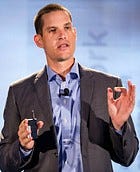3 Disruptive Networking Technologies Coming to Your Data Center3 Disruptive Networking Technologies Coming to Your Data Center
There's at least one you might not expect.

Gartner has revealed its top three most disruptive technologies set to impact data center networking by 2025.
Andrew Lerner, research VP at Gartner, said organizations should expect to see these technologies in their data center by 2025.
1. Consumption-Based Delivery
The first is not a technology, but a consumption-based delivery model, said Lerner, who was speaking at VMware’s Future:Net event.

Gartner’s Andrew Lerner
“The architectural definition of cloud is self-service. You get what you want, via an API, or a UI within moments. You then get billed for what you use. If you contrast that to the last couple of big data center networking purchases you’ve made, that doesn’t really jibe. It’s certainly not consumption-oriented, and on-demand and self-service.
“We’ve seen vendors trying to deliver things so that you can procure in a more cloud-like way — separating hardware from software and charging for it separately, shifting software to be subscription-based, changing the management portal and delivering it as a service.
“The next thing you’re going to see is hardware as a service. This is where you subscribe to the hardware versus buy it at fixed, per-port monthly pricing. By 2023 we predict that at least two major data center networking vendors will offer monthly fixed, per-port pricing as a procurement option. By 2025, 30% of enterprises will procure at least some of their data center switches via a hardware-as-a-service model.
2. SONiC (Software for Open Networking in the Cloud)
“SONiC is an open source network operating system, originally driven by Microsoft. You can run it on a wide hardware variety of switches; nearly all white boxes support it. But real-world deployment in the enterprise is nonexistent at this point. There are a couple of large providers doing it, like Azure and Tencent. And some service providers, but nobody in the enterprise is doing it.
“This is important because it has the capability to unlock innovation in networking like we haven’t seen before,” he said.
Lerner gives the analogy of Linux to demonstrate the potential of SONiC.
“If we walk into the enterprise today, most server OSS are either Linux or Microsoft. Linux transcends hardware; it transcends vendor. There’s Linux-based tooling and automation, and Linux as a skill set. It can go up in many different places. So, think about if SONiC does that in the data center network. You get this vendor-agnostic, hardware-agnostic ecosystem and skill set that that unlocks innovation in the data center. By 2025 our prediction is that 40% of large data center environments will run SONiC somewhere in their production environment.”
3. Function Accelerator Cards (FAC)
“FAC it is a next generation smart NIC,” he continued. “It is a NIC that goes into a server with a chip on it, which can do hardcore networking functions. In running those functions, you can free up the server from processing, like virtual switching. Or you could start to eat away at the middleboxes in the environment, like a firewall or a load balancer. And if you’re running a NAS on it, it becomes a leaf switch. There are very compelling price performance characteristics of a function accelerator card for certain workloads.”
Lerner said we’re already seeing adoption of function accelerator cards in large hyperscale event environments.
“These are the same environments that pioneered the patterns we see in enterprise networks today like leaf spine with Linux-based automation tools. By 2023, we predict that one in three NICs going out the door will be a function accelerator card,” he added.
One Extra Prediction
Lerner said it is important to know where things are not going as well in data center networking.
“Most data center networking vendors today are big on this notion of multicloud — or extending their on-premises policy engine and construct and console into the public cloud. So as the workload goes to Azure or Amazon, you can get single-pane-of-glass troubleshooting visibility. But the reality is, we do not see adoption of that to any significant degree.
“We project that behavior will continue so that through 2023, 90% of customers will continue to not bring their established data center networking stack for their workloads into the public cloud.”
Read more about:
VARs/SIsAbout the Author
You May Also Like


